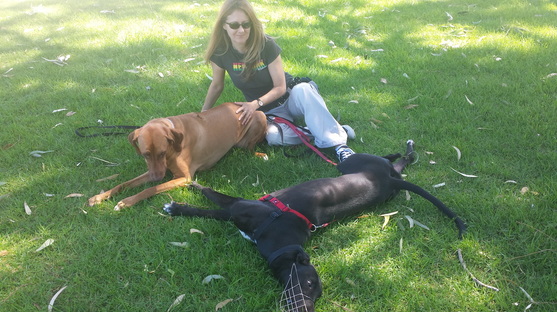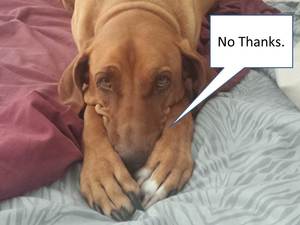* To keep the first dog company and be a playmate
* Because one dog is getting older
* To prevent separation anxiety in the existing dog
* To reduce barking, chewing, digging, escaping or {insert any problem} in the existing dog
* To meet a need or goal that the existing dog doesn’t e.g. agility, jogging partner, showing
* To save a dog’s life from a shelter, rescue or death
* On impulse: the cute pet shop puppy, the neighbour’s puppies, a needy stray
* Because one simply loves dogs: the more the merrier
A quick word of wisdom regarding getting a second dog to solve separation anxiety or other problem behaviours in an existing dog: unless the current dog has been assessed and professional advice recommends a second dog is warranted – it’s a gamble. A second dog may help. A second dog could have no effect. A second dog might increase the problem. A second dog may prove to be a problem himself.
If a second dog is planned, it’s a good idea to ask what your first dog thinks of the whole idea. Not every dog wants to share their home with another dog. Not every dog is compatible with every other dog. Just like people really.
Zuri had access to the backyard through a dog door. Turbo slept outside at night and also spent some time outside during the day whilst Zuri was inside. Some reasons for this were;
* to see how Turbo went being alone in case his new home didn’t have a second dog,
* to keep them separated for safety until I was certain they would be OK together alone,
* to get him used to being outside in case his new home preferred to keep him outside, and
* to give Zuri some space.
In the first week I started noticing changes in Zuri’s behaviour.
1. She stopped using her outside bed.
2. She stopped using the dog door. Initially she would stick her head through, see Turbo and
retreat back inside. Eventually she stopped using it altogether.
3. She stopped going out into the back yard to toilet.
4. She stopped leaving the back deck to go onto the lawn.
5. She stopped going out the back altogether, even through the sliding door, even if I went out.
Since she stopped going to the toilet out the back, I had to take her out the front. This meant she relied on me and this changed her usual toileting schedule. This, combined with some stress of a new housemate, led to her developing a urinary tract infection about two weeks after Turbo arrived. But wait, there's more:
6. She stopped eating in her usual place outside.
7. She wouldn’t go through doorways or come in if he was standing near.
8. She wouldn’t engage in play with him even after eight weeks.
9. She wouldn’t pass him in the hall or would make a wide arc to pass.
10. She’d walk away if he came and sniffed whilst she was sniffing or licking something.
11. She’d walk away from me if he approached me.
12. She began to run to the front door when I picked up my car keys and bag.
13. Once at the door, she would push her head into the flywire and ignore my request for her
to back up or stay.
14. If I let her out, she would run to the car and stand at the car door.
15. Once, when I couldn’t take her with me, she kept circling the car instead of coming back
inside.
16. Finally, something I only just realized because I’d been preoccupied when walking two
dogs…she stopped doing zoomies at the beach on our walks with Turbo.
I’ve had dogs stay before. The longest it has taken before she would play with a dog living with us has been four days. A dog she avoided with a passion eventually became a great playmate after a few beach sessions. And to lose the zoomies? She’s trying to tell me something.
Turbo is a wonderful dog. He is gentle and sensitive, he’s shown no aggression, even over food. But he’s not a perfect match for Miss Zuri. He’s a big, goofy doofus who has no space bubble. He thinks nose-to-nose is giving you space. He thinks nothing of nudging Zuri’s nose out of the way to sniff or lick her mouth after she’s eaten, or push past her to the door or through the passage, or to body slam her during play. Zuri has a big space bubble. Sometimes looking at her is too close! Some dogs may be able to work this out and adapt to each other’s style. Zuri has done it with her buddy, barky, pushy, in-yah-face Sam. They both changed slightly to meet in the middle. Turbs and Zuri seem to be on a different wavelength.
Some people have asked why I don’t keep the magical, wonderful Turbo because he really is a lovable goofball. I just tell them, “Zuri says, ‘No’!”



 RSS Feed
RSS Feed